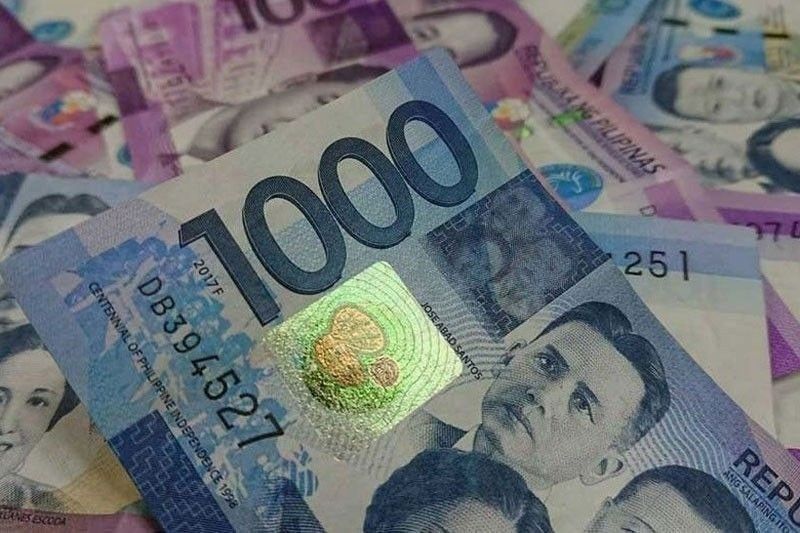Peso breaches 56:$1 level

MANILA, Philippines — The peso breached the 56 to $1 level after shedding 39 centavos to close at 56.06 from Wednesday’s 55.67, amid heightened downward pressures from the widening current account deficit arising from strong imports, as well as the tighter external financing environment.
The local currency opened weaker at 55.90 and lost steam to hit an intraday low of 56.09. The peso’s intraday high was at 55.78. Trading volume declined by 10.5 percent to $1.11 billion from $1.24 billion on Wednesday.
ING Bank senior economist Nicholas Mapa said a more aggressive tightening is needed from the Bangko Sentral ng Pilipinas (BSP), especially after the US Federal Reserve raised interest rates by 75 basis points last June 15.
“General strong US dollar in play, but a relatively dovish BSP against the backdrop of a hawkish Fed isn’t helping,” Mapa said.
In its latest commentary, Fitch Solutions Country Risk & Industry Research said it now expects the peso to average 54.30 instead of 52.30 this year and 56.40 instead of 53 next year.
In terms of average, the local currency has depreciated by 11.6 percent to 54.96 to $1 so far this year from 49.25 to $1 last year.
“The widening of the Philippines’ current account deficit coupled with tightening global monetary conditions will likely exert further downward pressure on the peso,” Fitch Solutions said.
The research arm of the Fitch Group now expects the country’s current account shortfall to swell to 4.3 percent of gross domestic product instead of 2.4 percent of GDP this year on the back of higher commodity prices and the reduction of tariffs.
“We expect the widening current account deficit and deteriorating terms of trade to continue exerting downside pressure on the peso in the near-term,” it said.
Latest data showed the current account deficit widening to five percent of GDP in the first quarter of the year from 3.5 percent in the fourth quarter last year as imports surged by 27.8 percent versus the 5.9 percent increase in exports.
Over the coming quarters, Fitch Solutions expects the current account balance to remain in a deficit due to elevated commodity prices and strong import demand, especially after the government implemented a slew of tariff cuts in an attempt to tame rising prices.
The government has extended an executive order that lowers the tariff rate for rice imported outside Southeast Asia to 35 percent from a range of 40 to 50 percent until the end of the year.
Additionally, it also slashed tariffs on corn and pork, and announced the temporary removal of a seven percent duty on coal imports.
According to Fitch Solutions, tightening global monetary conditions would also continue to weigh on risk sentiment and therefore put downward pressure on the peso.
As major central banks around the world turn increasingly hawkish and continue hiking rates aggressively, capital will likely be diverted away from emerging economies, such as the Philippines, and into fixed income assets in developed countries which are considered less risky,” it said.
The US Federal Reserve raised interest rates by 75 basis points last June 15, the highest since 1994, to curb rising pressures as inflation hit its highest level in 40 years.
The Bangko Sentral ng Pilipinas (BSP) has started adjusting its policy rates after delivering back-to-back 25 basis points rate hikes in May and June, as inflation stayed above the government’s two to four percent target.
Inflation soared to 6.1 percent in June from 5.4 percent in May and averaged 4.4 percent in the first half of the year. The BSP Monetary Board raised its inflation forecasts to five instead of 4.6 percent this year and to 4.2 instead of 3.9 percent next year.
“Furthermore, real interest rate differentials will likely remain in favor of the US over the coming months as we expect the BSP to hike its policy rate by 75 basis points to 3.25 percent by end of 2022 compared to an additional 150 basis points in the US, which will bring the federal funds rate to 3.25 percent,” Fitch Solutions said.
The narrowing real interest rate differential between the US and the Philippines could likely lead to hot money outflows.
On the other hand, Fitch Solutions said the easing of foreign ownership restrictions should attract more foreign direct investments into the Philippines, providing structural support for the currency.
Fitch Solutions said the pace of peso depreciation would likely be relatively gradual in the coming months as the BSP has ample foreign reserves to intervene in the foreign exchange market if necessary to smooth downside volatility.
From a technical perspective, the peso has broken out of a major support level at around the 54.50 to $1, with the next major support line at around 56.50 to $1.
- Latest
- Trending





























